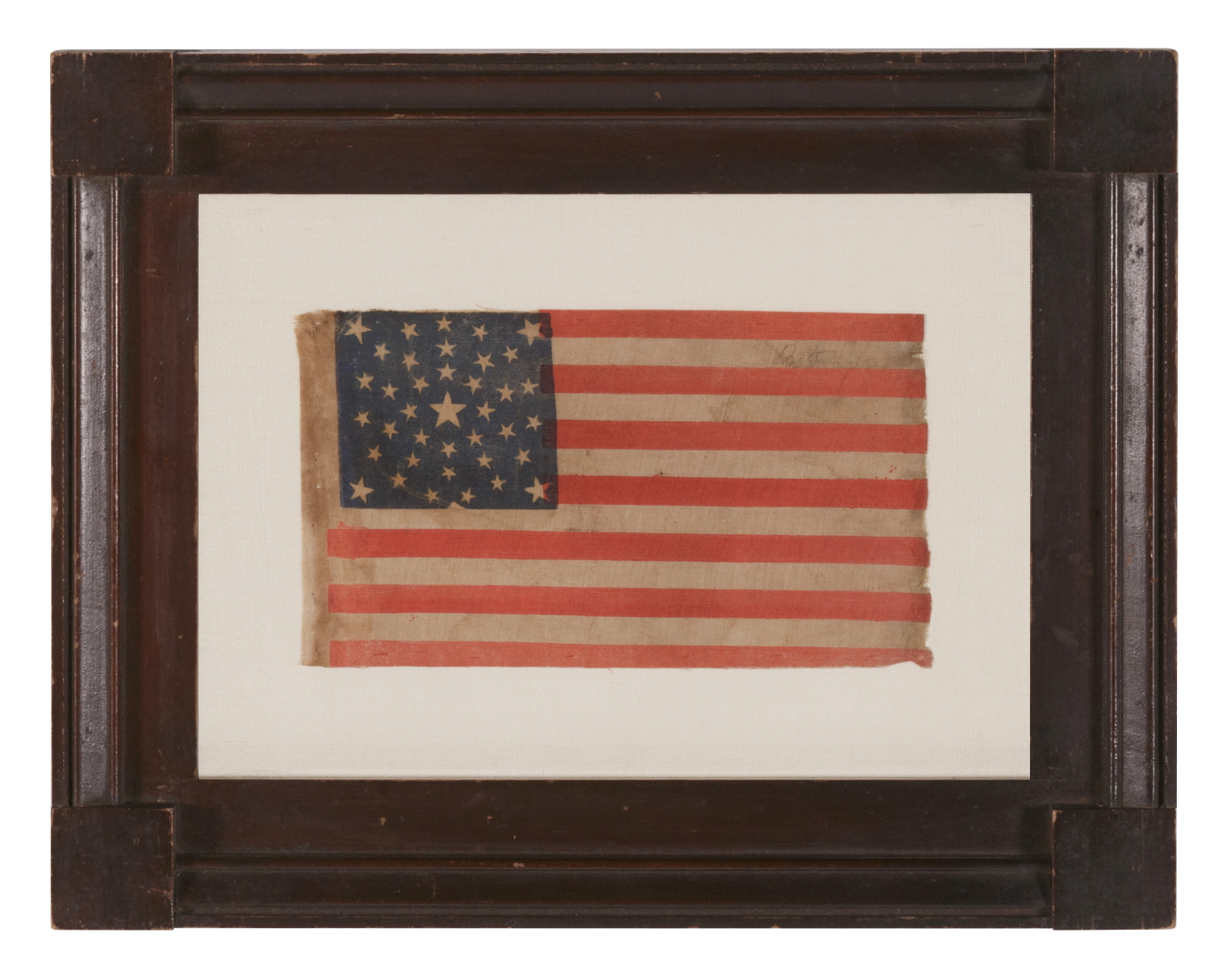
| |
38 STARS IN A "SUMMER SKY" MEDALLION, A RARE EXAMPLE, COLORADO STATEHOOD, 1876-1889 |
|
| Available: |
Sold |
| Frame Size (H x L): |
14.25" x 18.25" |
| Flag Size (H x L): |
5.75" x 10" |
|
| Description....: |
|
38 star American national parade flag, printed on coarse cotton. The stars are arranged in a triple-wreath form of the medallion configuration, with a larger, flanking star in each corner of the blue canton and an even larger star in the very center. This particular variety has sometimes been termed a “summer sky” medallion, due to the fact that the design spans most of the available space in the canton and is reminiscent of a clear summer night, filled with stars. In addition to being beautiful, this is a very scarce example among surviving 38 star parade flags.
Note how the crude nature of the block printing provides features that accentuate its hand-made nature. These imperfections, in addition to the whimsical star pattern, add strong folk qualities to the overall design.
Colorado became the 38th state on August 1st, 1876. This was the year of our nation’s 100-year anniversary of independence. Per the Third Flag Act of 1818, stars were not officially added until the 4th of July following a state's addition. For this reason, 37 was the official star count for the American flag in 1876. Flag-making was a competitive venture, however, and few flag-makers would have been continuing to produce 37 star flags when their competitors were making 38’s. It is for this reason that 38 and 13 stars (to represent the original 13 colonies) are more often seen at the Centennial International Exposition, the six-month long World’s Fair held in Philadelphia in honor of the event. Some flag-makers would have been adding a star for the 38th state even before it entered the Union, in the early part of 1876 or even prior. In fact, many makers of parade flags were actually producing 39 star flags, in hopeful anticipation of the addition of two more Western Territories instead of one. But the 39th state would not join the Union for another 13 years, when the Dakota Territory entered as two states on the same day. The 38 star flag became official on July 4th, 1877 and was generally used until the addition of the Dakotas in 1889.
The name “Butsinger” is inscribed in pencil along the 1st white stripe, near the fly end. This would be the name of a former owner and it was common to mark flags in this manner during the 19th century to indicate ownership.
Mounting: The Hicks style corner block frame has mortise and tenon construction, dates to the period between 1810 and 1830, and retains its original painted surface. The flag has been hand-stitched to 100% hemp fabric. Spacers keep the textile away from the glazing, which is U.V. protective glass.
Condition: There is moderate soiling throughout, accompanied by modest fabric loss along the fly end and along the last stripe in the bottom, fly end corner. Antique flags are an anomaly among early American textiles. In most categories, perfection is coveted. Flags, however, are expected to have been used outdoors. Many of my clients prefer them to show their age and history of use, finding that expected wear can sometimes actually add to the presentation rather than detract. |
|
|
|
| Collector Level: |
Advanced Collectors and the Person with Everything |
|
| Flag Type: |
Parade flag |
|
| Star Count: |
38 |
|
| Earliest Date of Origin: |
1876 |
|
| Latest Date of Origin: |
1889 |
|
| State/Affiliation: |
Colorado |
|
| War Association: |
1866-1890 Indian Wars |
|
| Price: |
SOLD |
|
| |
Views: 1378 |
|
|
|

